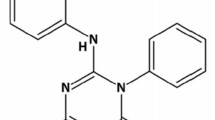Summary
Human subjects given C14-mescaline by mouth excrete an average of 87% of the dose during the first 24 hours and an average of 92% during the first 48 hours. Average half-life of mescaline in six hours.
The composition of the urine in respect to the various metabolites of mescaline from hour to hour has been determined. The concentration of mescaline and its metabolites in the plasma and the cerebrospinal fluid at the various times has also been determined.
Mescaline, 3,4,5-trimethoxyphenylacetic acid, N-acetyl-β-(3,4-dimethoxy-5-hydroxyphenyl) ethylamine and N-acetyl-mescaline have been identified in human urine after mescaline administration in the following amounts: mescaline 55–60%, 3,4,5-trimethoxyphenylacetic acid 27–30%, N-acetyl-β-(3,4,dimethoxy-5-hydroxyphenyl) ethylamine 5% and N-acetylmescaline less than 0.1%. Five other metabolites have been partially characterized.
Chromatographic evidence is presented for the presence of mescaline, 3,4,5-trimethoxyphenylacetic acid, N-acetylmescaline and N-acetyl-β-(3,4-dimethoxy-5-hydroxyphenyl) ethylamine in the cerebrospinal fluid in man after oral mescaline administration.
Similar content being viewed by others
References
Baillie, L. A.: Determination of liquid scintillation counting efficiency by pulse height shift. Int. J. appl. Radiat. 8, 1–7 (1960).
Block, W., K. Block u. B. Patzig: Zur Physiologie des 14C-radioaktiven Mescalins im Tierversuch. III. Mitteilung. Mescalineinbau in Leberprotein. Hoppe-Seylers Z. physiol. Chem. 291, 119–218 (1952).
—: Zur Physiologie des 14C-radioaktiven Mescalins im Tierversuch. IV. Mitt. Vergleichende Untersuchungen mit 14C-Mescalin und 14C-β-phenyl-äthylamin. Z. Naturforsch. 8b, 440, 444 (1953).
Charalampous, K. D., and J. Kinross-Wright: Hallucinogens, tools for research or therapeutic agents. Tex. St. J. Med. 59, 848–852 (1963).
—, A. Orengo, K. E. Walker, and J. Kinross-Wright: Metabolic fate of β-(3,4,5-trimethoxyphenyl)-ethylamine (Mescaline) in humans: isolation and identification of 3,4,5-trimethoxy-phenylacetic acid. J. Pharmacol. exp. Ther. 145, 242–246 (1964).
Downing, D. F.: The chemistry of psychotomimetic substances. Quart. Rev. (Lond.) 16, 133–162 (1962).
Fischer, R.: Pharmacology and metabolism of mescaline. Rev. canad. Biol. 17, 389–409 (1958).
Giarman, N. J., and D. X. Freedman: Biochemical aspects of the actions of psychotomimetic drugs. Pharmacol. Rev. 17, 1–25 (1965).
Jacobsen, E.: The clinical pharmacology of the hallucinogens. Clin. Pharmacol. Ther. 4, 480–503 (1963).
Kalberer, F., u. U. J. Rutschmann: Eine Schnellmethode zur Bestimmung von Tritium, Radiokohlenstoff und Radioschwefel in beliebigem organischem Probematerial mittels des Flüssigkeits-scintillations-Zählers. Helv. chim. Acta 44, 1956–1966 (1961).
Lajtha, A.: Biochemistry of hallucinogens. In: Psychopharmacology, pharmacologic effects on behavior. Edited by Pennes, H. H. New York: Hoeber 1958.
Mokrasch, L. C., and I. Stevenson: The metabolism of mescaline with a note on correlations between metabolism and psychological effects. J. nerv. ment. Dis. 129, 177–183 (1959).
Neff, N., G. V. Rossi, G. D. Chase, and J. L. Rabinowitz: Distribution and metabolism of mescaline-C14in the cat brain. J. Pharmacol. exp. Ther. 144, 1–7 (1964).
Rinkel, M.: The presidential address: the LSD movement in America. Paper read at Soc. Biol. Psychiat., New York City, April–May, 1965.
Slotta, K. H., u. J. Müller: Über den Abbau des Mescalins und mescalinähnlicher Stoffe im Organismus. Hoppe-Seylers Z. physiol. Chem. 238, 14–22 (1936).
Smith, A. A., and S. B. Wortis: Formation and metabolism of N-acetylnormetanephrine in the rat. Biochim. biophys. Acta (Amst.) 60, 420–422 (1962).
Weissbach, H., B. G. Redfield, and J. Axelrod: The enzymic acetylation of serotonin and other naturally occurring amines. Biochim. biophys. Acta (Amst.) 54, 190–192 (1962).
Author information
Authors and Affiliations
Additional information
This investigation was supported in part by Public Health Service Research Grant, MH-10777, from the National Institute of Mental Health.
Rights and permissions
About this article
Cite this article
Charalampous, K.D., Walker, K.E. & Kinross-Wright, J. Metabolic fate of mescaline in man. Psychopharmacologia 9, 48–63 (1966). https://doi.org/10.1007/BF00427703
Received:
Issue Date:
DOI: https://doi.org/10.1007/BF00427703




